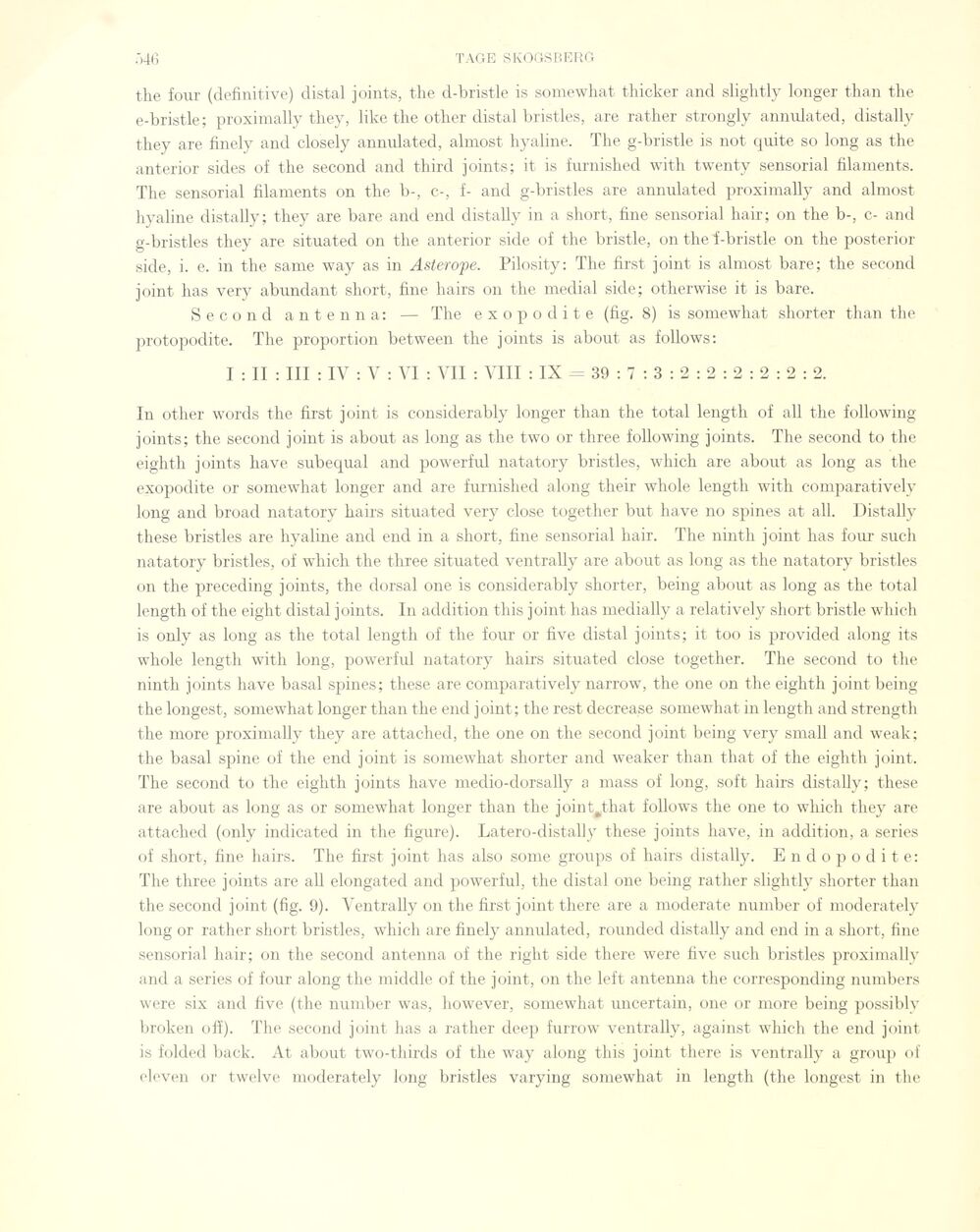
Full resolution (JPEG) - On this page / på denna sida - Sidor ...

<< prev. page << föreg. sida << >> nästa sida >> next page >>
Below is the raw OCR text
from the above scanned image.
Do you see an error? Proofread the page now!
Här nedan syns maskintolkade texten från faksimilbilden ovan.
Ser du något fel? Korrekturläs sidan nu!
This page has never been proofread. / Denna sida har aldrig korrekturlästs.
the four (definitive) distal joints, the d-bristle is somewhat thicker and slightly longer than the
e-bristle; proximally they, like the other distal bristles, are ratifier strongly annulated, distally
they are finely and closely annulated, almost hyaline. The g-bristle is not quite so long as the
anterior sides of the second and third joints; it is furnished with twenty sensorial filaments.
The sensorial filaments on the b-, c-, f- and g-bristles are annulated proximally and almost
hyaline distally; they are bare and end distally in a short, fine sensorial hair; on the b-, c- and
g-bristles they are situated on the anterior side of the bristle, on the f-bristle on the posterior
side, i. e. in the same way as in Asterope. Pilosity: The first joint is almost bare; the second
joint has very abundant short, fine hairs on the medial side; otherwise it is bare.
Second antenna: — The exopodite (fig. 8) is somewhat shorter than the
protopodite. The proportion between the joints is about as follows:
I : II : III : IV : V : VI : VII : VIII : IX = 39 : 7 : 3 : 2 : 2 : 2 : 2 : 2 : 2.
In other words the first joint is considerably longer than the total length of ail the following
joints; the second joint is about as long as the two or three following joints. The second to the
eightli joints have subequal and powerfid natatory bristles, which are about as long as the
exopodite or somewhat longer and are furnished along their whole length with comparatively
long and broad natatory hairs situated very close together but have no spines at ail. Distally
these bristles are hyaline and end in a short, fine sensorial hair. The ninth joint has four such
natatory bristles, of which the three situated ventrally are about as long as the natatory bristles
on the preceding joints, the dorsal one is considerably shorter, being about as long as the total
length of the eight distal joints. In addition this joint has medially a relatively short bristle which
is only as long as the total length of the four or five distal joints; it too is provided along its
whole length with long, powerful natatory hairs situated close together. The second to the
ninth joints have basal spines; these are comparatively narrow, the one on the eighth joint being
the longest, somewhat longer than the end joint; the rest decrease somewhat in length and strength
the more proximally they are attached, the one on the second joint being very small and weak;
the basal spine of the end joint is somewhat shorter and weaker than that of the eighth joint.
The second to the eighth joints have medio-dorsally a mass of long, soft hairs distally; these
are about as long as or somewhat longer than the jointjfiiat follows the one to which they are
attached (only indicated in the figure). Latero-distally these joints have, in addition, a series
of short, fine hairs. The first joint has also some groups of hairs distally. Endopodite:
The three joints are ali elongated and powerful, the distal one being rather slightly shorter than
the second joint (fig. 9). Ventrally on the first joint there are a moderate number of moderately
long or rather short bristles, which are finely annulated, rounded distally and end in a short, fine
sensorial hair; on the second antenna of the right side there were five such bristles proximally
and a series of four along the middle of the joint, on the left antenna the corresponding numbers
were six and five (the number was, however, somewhat uncertain, one or more being possibly
broken off). The second joint has a rather deep furrow ventrally, against which the end joint
is folded back. At about two-tkirds of the way along this joint there is ventrally a group of
eleven or twelve moderately long bristles varying somewhat in length (the longest in the
<< prev. page << föreg. sida << >> nästa sida >> next page >>